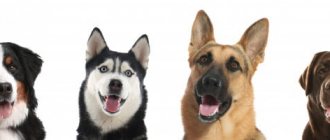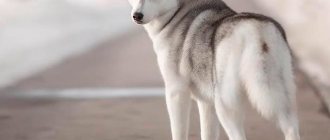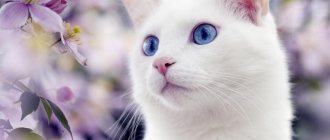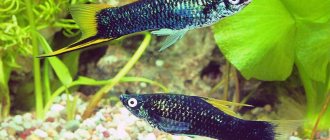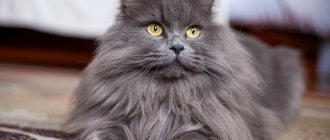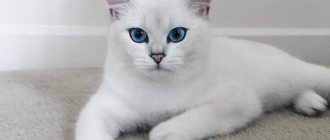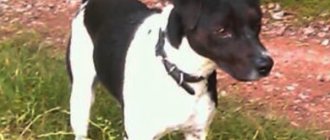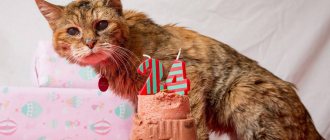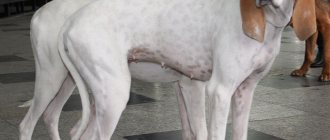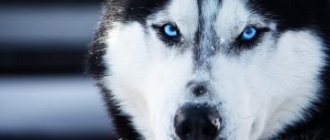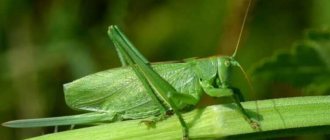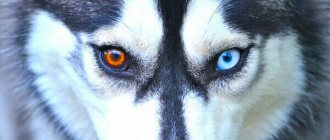Dogs are very attractive and cute animals. And if it also happens that the dog has blue eyes, then it becomes even more charming. It is worth understanding that the breed in no way affects the color of the iris, it all depends on the gene, which is recessive, that is, not as strong as the dominant one. But sometimes, even if a puppy has blue eyes at birth, as they grow older they can change their shade.
The color blue is not limited to just one breed of dog.
Sheltie
Marbled Sheltie
The predecessors of the Sheltie were bred for herding work in the Shetland Islands near Scotland. Outwardly, they resemble smaller long-haired collies, but are recognized as an independent breed. Blue eye color is allowed for Shelties with the merle gene, which is responsible for the merle color.
French Bulldog
The breed was developed in England. Used as a companion for the owner and as a home rat trap. The dogs were popular among English seamstresses. Then they appeared on the continent, becoming a prestigious breed among the French aristocracy. The animal is small in size, very strong and agile. Distinctive features are short hair and a muzzle with a flat nose. The dog is very cheerful and active. He is distinguished by his special love for children, coming to their defense in case of danger.
Shepherd panda
Panda shepherd dogs were bred relatively recently in the United States. The list of breeds that participated in the selection is not disclosed. The bright color of the animals combines 2 or 3 contrasting colors. Must include large white spots that cover at least one eye. Panda Shepherd Dogs are not recognized by the FCI, but are popular and registered in the USA. Blue-eyed dogs participate in exhibitions along with dark-eyed ones.
Crossbreeds
Now that we've covered purebred breeds, we can't leave out the fantastic mixed breed puppies that can also have blue eyes. The Siberian Husky is one of the few breeds with naturally blue eyes, so you'll see a few different Husky mixes on this list. There are also several Australian Husky crosses. Let's take a look at the best mixed breed puppies that can have blue eyes!
Pomsky
Pomskies can inherit blue eyes from their husky parents.
The Pomeranian Husky mix is a miniature version of the Husky and is quite expensive! This miniature fluffy husky is an attempt to get the soft and fluffy coat of an orange, complemented by the beautiful blue eyes of a Siberian husky. Pomskies are very popular designer dogs. They are highly sought after and often cost $3,000 or more in the US!
Saint Berchu
Thanks to heterochromia, inherited from their Husky parents, St. Bernards can have blue eyes.
The Saint Berhusky is a cross between the Siberian Husky and the Saint Bernard. This unique breed inherited blue eyes from its Husky parents. It is possible that they will end up with heterochromia, where they have one eye of each color. This cross will be a little calmer than the Siberian Husky, but with a slightly thicker, longer coat. These are large dogs whose weight can reach 100 kilograms.
Husky Inu
Most Huskies have brown eyes, but they can also be blue.
The Shiba Inu Husky mix is a mix of the Siberian Husky and the Shiba Inu. This crossbreed is similar to a Pomsky in that they are designer dogs that are in high demand. They come with a high price tag, with puppies often priced at $1,500 or more. This mix will be slightly smaller than the husky parent, and they often have a pair of stunning blue eyes.
Goberian
Gobers may have the blue eye gene inherited from their Husky parents.
The Gober breed is a mix of Golden Retriever and Siberian Husky. This unique mix can look completely different between two puppies from the same litter! However, it is a very popular crossbreed and is often used to produce a dog that looks like a Golden Retriever but with blue eyes. It is a medium to large sized cross and will do best in a large yard. Gobers have a lot of energy and are more socially adaptable to new environments than purebred Huskies.
Gerberian Shepsky
Like their Husky parent, Shepskies can have blue eyes.
The Husky German Shepherd mix is another breed that is commonly found with blue eyes. German Shepherds are reported to occasionally have pure blue eyes, but this is considered a breeding defect and is extremely rare. When crossed with a Husky, the chances of this breed having blue eyes are 50/50. This breed is extremely popular and comes in a medium to large size. They will do best in a house with a yard. They can live in an apartment, but they need regular exercise.
Haskador
Huskadors may have blue eyes, also inherited from the Husky.
The Huskador is another blue-eyed dog breed that is a cross between a Husky and a Labrador. This puppy will look more like its Labrador parent and will most likely carry the gene for blue eyes. Since the Labrador is one of the most popular breeds in the world, it makes sense to cross one with a Husky to see if they can get those beautiful blue eyes.
Horgi
Husky Corgi mixes may have blue eyes from Husky parents.
The Horgi is another beautiful crossbreed with blue eyes. This mix is a cross between a Husky and a Corgi. Since both parents have the gene for blue eyes, this crossbreed has a greater chance of producing puppies with blue eyes. The Horgi is a very cute puppy that is slightly larger than a full-sized Corgi. Another popular designer dog, this breed is medium in size and, due to its energy, is best suited for a home with a small yard.
Siberian Aussie
If both parents have blue eyes, then there is a high chance that the Siberian Aussie will have them too.
Another mixture of two potentially blue-eyed dog breeds is the Siberian Aussie. This designer dog is a mix of Australian Shepherd and Siberian Husky. These puppies are very energetic and are likely to have blue eyes. Their coats come in a variety of colors, from white and black to brown and merle. This cross will be slightly larger than an Australian Shepherd and slightly smaller than a Siberian Husky. They will need free space to roam as their energy levels are very high. Australian Siberian Huskies can become destructive without proper energy output.
Aussiepoo
Although rare, Aussiepoos can have blue eyes.
The Aussiepoo is a cross between an Australian Shepherd and a Poodle. The likelihood of this crossbred carrying the gene for blue eyes is lower since the Poodle is not known to have blue eyes at all. If an Australian Poodle receives the merle gene from its Australian Shepherd parents, then there is a chance that it will have blue eyes. This fluffy puppy will have a lot of energy. Their Poodle parent is extremely active. This breed can challenge even the most patient dog owner. It is recommended to have a large yard for backyard play or to exercise your Australian Poodle for at least 60 minutes daily.
Border Aussie
Blue eyes are common in Border Aussies because both parents carry the gene.
The Border Aussie crosses two potentially blue-eyed dog breeds by mixing a Border Collie and an Australian Shepherd. The Border Aussie is a bundle of energy and does best with plenty of exercise. Both parent breeds are likely to be merle, which means this cross may well have a pair of blue eyes to match its long, silky coat. Border Aussies can do well in an apartment as long as they get plenty of exercise. They love being around family and are affectionate dogs when they are not entertaining themselves. Border Aussies make excellent dogs for agility training and are very intelligent.
Aussidor
An Aussie can inherit blue eyes from its Aussie parents.
The Aussiedor is a cross between a Labrador Retriever and an Australian Shepherd. Only the Australian Shepherd parent carries the gene for blue eyes, but this still means that Australopithecus could have blue eyes. To achieve blue eyes, this pair will require merle wool. The Aussie is a loving and affectionate breed. Smaller than a purebred English or American Labrador, this mix lacks the enthusiasm of either parent. They will do well in a small yard if given regular exercise.
Australian Shepherd or Aussie
Aussie merle color.
Contrary to its name, the breed was bred in North America on the basis of shepherd dogs imported from Australia. Among Aussies, it is difficult to find two identical dogs. Each one develops a unique combination of shades and coat patterns. Marbled Aussies are often born with blue irises. This feature is specified in the standard.
Gray in the languages of the world
What does "gray" sound like in different languages? Let's get a look. Perhaps one of these names would be a great option for a dog.
For males you can consider:
- Gray;
- Grigio;
- Gris;
- Jairo;
- Silver;
- Argent;
- Lloyd;
- Qamar;
- Ranks;
- Liden;
- Liat;
- Grar;
- Chinzento;
- Kulai.
Baby Argent is settling into his new home.
Here are the options for a girl:
- Steele;
- Fuzi;
- Sidra;
- Shara;
- Hopo;
- Siwa;
- Seda;
- Grisa;
- Kharma;
- Zhurke;
- Verna;
- Gro;
- Peleka;;
- Hina;
- Shinishi;
- Purys;
- Isi.
Husky
These are the most popular blue-eyed dogs with a rich palette of iris shades: from pale azure to rich blue. More often, the blue iris is combined with black, gray shades of fur, less common in pure white, red, and chocolate huskies. Heterochromia is allowed when one eye is brown and the other is blue.
Blue eyes in a dog and related problems
Many owners and breeders refuse to breed purebred females and males with unusual bluish irises due to fear of medical problems for this and future generations. It is believed that blue-eyed dogs are susceptible to various ophthalmological diseases, and an animal with snow-white fur can even go blind.
The same applies to individuals with a very impressive marbled coloration caused by a mutation of the merle gene. With this coat color, pigment cells are suppressed in the iris and vascular network of the inner ear, which promises problems with hearing and vision. Dogs of this color with beautiful “heavenly” eyes often have a rather weak psyche and are sterile (this is how nature shows concern for the future of the population).
Merle color dog
Additional Information. The effect of this gene mutation can cause only one eye of the animal to be blue, and the other to be brown or gray.
The blue tint of the iris under the influence of the merle mutation accompanies the flattening of the fundus of the eye, which entails twilight (“night”) blindness - animals see poorly or not at all in the twilight.
Dogs with pigmented insufficiency of the iris exhibit heterochromia (“white-zor”), when the surface around the pupil appears bluish due to the looseness of the connective tissue of the eye, and the edges of the sclera and the area in the center of the eye glow with a blue-gray tint. Most of these animals are considered breeding stock. They may additionally experience malocclusion and dysplasia.
Border Collie
Breed selection began in the border areas of England and Scotland in the 19th century. Now Border Collies have spread throughout the world and are renowned as the most trainable dogs. A blue iris is typical for the blue merle border collie (blue merle), less often combined with two-tone colors.
Popular nicknames
You can give your pet a popular name. It sounds good and is easy to pronounce. Below is a list of possible options.
We recommend watching: 433+ beautiful names for small dogs for girls
For boy:
- Asher;
- Dean;
- Grayson;
- Phantom;
- Ringo;
- Bourbon;
- Troy;
- Forbes;
- Grade;
- York;
- Kenzie;
- Leeds;
- Austin;
- Rider;
- Pluto;
- Soup and;
- Somber;
- Tinsel;
- Logan;
- Fidel;
- Bernard;
- Conrad;
- Cortes;
- Largo;
- Dobson;
- Gard;
- Buckler;
- Cortes;
- Laurel;
- Marquis;
- Nivago;
- Orlan;
- Pluto;
- Asteroid;
- Tyson;
- Uranus;
- Hertz;
- Guinness;
- Valdai;
- Simon;
- Byron;
- Baggio;
- Edgar;
- Ramir;
- Alvin;
- Sherman;
- Lapwing.
And this is Bernard
For the girl:
- Ariana;
- Zara;
- Haida;
- Blair;
- Dora;
- Freya;
- Nala;
- Serena;
- Adele;
- Tina;
- Wendy;
- Digby;
- Jenna;
- Eileen;
- Bark;
- Courtney;
- Lana;
- Nessie;
- Ella;
- Chloe;
- Fergie;
- Fleur;
- Una;
- Kira;
- Blair;
- Arika;
- Bendis;
- Riva;
- Lorna;
- Vivien;
- Jacqueline;
- Michelle;
- Sarah;
- Viola;
- Sophie;
- Miranda;
- Cynthia;
- Sibylla;
- Shandy;
- Chally.
Fergie and her unusual color
Collie long-haired and short-haired
These are 2 related but distinct herding breeds from Scotland. Friendly dogs have earned a reputation as intelligent companions and sensitive nannies for children. Blue irises are only allowed for Blue Merle Collies. In animals with sable, tri-colored coat it occurs occasionally, but is considered a fault.
Animal character
The gray Cane Corso is people-oriented; he is very dependent on his owner emotionally and is ready to do anything for him.
Despite the fact that these dogs have become famous since ancient times as tough fighters and brave watchmen, they are friendly and affectionate with the owner and members of his family.
They make wonderful nannies for children - Corsos simply adore them and treat their children with extreme care and attention..
They are able to get along with any animals in the house, and even on the street they treat other dogs, as well as other living creatures, be it cats or birds, quite favorably.
These dogs are distinguished by their intelligence and intelligence - they easily learn commands, but still, it is better not to train a gray Corso on your own, but to entrust it to an experienced dog handler, since these dogs are quite large and therefore unconditional obedience is an urgent necessity for them.
Expert opinion
Kozhevin Semyon Kirillovich
Expert dog handler.
“It’s hard to name a better defender than the Cane Corso. My gray dog will not hesitate to give his life for us if necessary. He is very attached to our family and for us this is a huge plus, but for some, such an obsession with the owner may seem excessive. He is very smart, easy and pleasant to train, but, however, he can be slow, like other Molossians. These are strong and resilient animals, so physically handling them is not easy, and in order to even accidentally prevent a conflict situation, the gray Cane Corso must be trained just perfectly. But, despite all the advantages of the breed, the Corso is not a dog for everyone, since it requires a large investment of effort, money and soul.”
Read more about the character of the Cane Corso here.
Dachshund
Hunting dogs with a long body and short legs. Within the breed, as many as 9 groups of dogs were formed:
- 3 size types: standard, miniature and rabbit dachshunds.
- 3 groups according to coat type: smooth short, semi-long and coarse hair.
Marbled dachshunds are sometimes born with clear blue eyes. Light iris color is not welcome, but is acceptable. Animals of other colors will be disqualified for this.
German dog
This royal breed combines large size and power with elegance. They have square, well-balanced proportions. The gait is strong and powerful, with long, easy steps. The coat is short, thick, shiny. The Great Dane is particularly notable for its majestic posture and blue-eyed appearance, and is also called the "Apollo of the Dog." This is a German breed, and in 1876 the breed was declared the national dog of Germany.
The Great Dane is energetic, courageous, friendly and reliable. He is generally good with children (although his friendly overtures may overwhelm a small child) and is generally friendly towards other family dogs and animals, but like all large dogs, requires supervision. After completing the training, he will become a pleasant and well-mannered companion in the family.
Marble Spitz
Small fluffy dog of German origin. Spitz dogs with the merle gene were bred artificially by crossing with merle shelties. In the International Film Festival and the RKF, this coat color is considered a defect; animals are not registered and are not allowed to participate in exhibitions. In the USA, marbled Spitz dogs are officially bred and have been added to the standard. The merle gene affects the color of the iris: Pomeranians are sometimes born with blue eyes.
English nicknames
First, let's look at the nicknames common in Foggy Albion. Let a little (or not so little) Englishman live in your house.
Suitable for a boy:
- Dusty;
- Ashes;
- Rocky;
- Smokket;
- Sam;
- Charlie;
- Harry;
- Bond;
- Harold;
- Rudy;
- Goodley;
- Duke;
- Murphy;
- Benson;
- Ladd;
- Aidan;
- Doji;
- Jagger;
- Fast;
- Bowie;
- David;
- Boswell;
- Worcester;
- Glenmore;
- Duncan;
- Donovan;
- Callahan;
- Newt;
- Yardley;
- Hart;
- Spencer;
- Brewster;
- Shelby;
- Rainey;
- Comstock;
- Thomas;
- Gaston;
- Jim;
- Garrett;
- Neville;
- Richard;
- Hamlet;
- Arnold;
- Charles;
- Anthony;
- Clifford;
- Grant;
- Horace;
- Lucas;
- Nathan;
- Shane;
- Thomas;
- Tristan;
- Wilfred;
- Matthew;
- Malcolm;
- Hubert;
- Abell;
- Barry;
- Vern;
- Gideon;
- Jeremiah;
- Devin;
- Crofford;
- Kimball;
- Malone;
- Nigel;
- Acton.
Nicknames for girls:
- Kurzi;
- Bindi;
- Blossom;
- Stella;
- Brenda;
- Umber;
- Lauren;
- Abby;
- Shauna;
- Isla;
- Gemma;
- Imogen;
- Ginger;
- Daisy;
- Playful;
- Alesta;
- Beauty;
- Vanessa;
- Gladys;
- Dottie;
- Derby;
- Imogen;
- Cadbury;
- Lara;
- Madeleine;
- Myrtle;
- Edith;
- Heather;
- Tierney;
- Brenda;
- Gracie;
- Hekla;
- Myra;
- Jesse;
- Avelina;
- Aella;
- Alexa;
- Adamina;
- Ada;
- Aleta;
- Alvena;
- Acarleia;
- Azalea.
Beauty Alesta
Alaskan Klee Kai
Klee Kais are similar to Huskies, but much smaller in size:
- toy – up to 34 cm;
- mini – up to 38 cm;
- standard – up to 43 cm.
The breed has appeared recently, but a standard has already been developed for it in the AKC. Typical colors of Alaskan Klee Kais are a combination of white with black, gray, and brown. Any eye color is allowed.
History of the breed
The history of gray Cane Corsos is as ancient as that of dogs of this breed of other colors.
Despite the fact that preference has always been given to a black Corso, often puppies of other colors were born in litters, including gray or blue, which are a variant of a weakened black color.
One can even assume that it was gray that was the first color option for the fur of these animals, which appeared in addition to the traditional black.
Some experts believe that the gray Cane Corso originated from a mixture of two traditional Italian breeds, which are descendants of the ancient Roman fighting dogs - the Corso and the Neapolitan Mastiff.
However, it appears that the gray color appeared in each of these two breeds as a result of a mutational weakening of the black color gene.
The ancestors of these dogs, in turn, descended from Tibetan mastiffs, appeared in Southern Italy in ancient times . Their main purpose, along with guarding, hunting and herding livestock, was also participation in military campaigns and gladiatorial battles.
These dogs, which have retained their strength, power and excellent guard qualities to this day, were depicted in ancient frescoes, mosaics and, later, ceremonial portraits.
Already in ancient Roman images you can see these majestic gray animals, as if cast from silver or lead, often dressed in special armor.
Later, gray Cane Corsos were successfully used as guards and hunters of large game, such as wild boar..
In the middle of the 20th century, all Corsos, regardless of color, were on the verge of extinction and only through the efforts of enthusiasts was the breed saved from final extinction.
It is possible that when the livestock was restored using the same mastino for breeding, dogs of a grayish-blue color appeared, which have no common relationship with those gray Corsos that appeared in ancient times as a result of a mutation in the black color gene.
